Training your dog may not be limited to: in the world There is a sport for tailed and their owners. And if you still don’t know what you can do with your pet in your free time, then you definitely need to try it.
Content
- 1 Sport with a dog: why is it needed
- 2 Sports with a dog
- 2.1 Agility
- 2.1.1 Photo Gallery: Agility Shells
- 2.2 Waitingpool
- 2.3 Dog Frisbee
- 2.3.1 Video: Frisbee Freestyle
- 2.4 Dog Training Freestyle, or dancing with a dog
- 2.4.1 Video: Dog Training Freestyle
- 2.5 Riding (sledding)
- 2.6 Dryland
- 2.6.1 Canicross
- 2.6.2 Bike Joring
- 2.6.3 Karting
- 2.7 Dog pulling (tug of war)
- 2.8 Coursing
- 2.9 Dog Racing
- 2.10 Rally Obedience
- 2.11 Pitch & Go
- 2.12 Fast Track
- 2.13 Flyball
- 2.14 Diving Diving
- 2.15 Nozvork
- 2.1 Agility
Sport with a dog: why is it needed
Contents
- 1 Sport with a dog: why is it needed
- 2 Sports with a dog
The main character in this lesson is the dog. While playing sports, she develops the following qualities:
- force;
- speed;
- endurance;
- dexterity;
- ability to make independent decisions;
- in some sports – the ability to use one’s feelings (scent, vision, hearing, etc.).
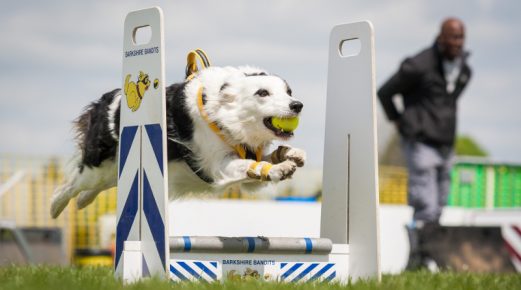
Sport with a dog is a fairly common occurrence.
In addition, sport with the dog makes it more obedient and helps to keep fit. Dogs and masters involved in sports, usually understand each other much better. Sport with a dog is also excellent stress prevention: completely forgetting to train, you forget about your problems. And pets can win trophies, which is a considerable cause for pride.
But in order for the dog to become an athlete, you need her prepare:
- Take obedience courses.
- Then – the general course of training.
- Courses UGS (“Managed City Dog”) – optional, for those who want the dog to be perfectly obedient or become the champion.
- Courses ZKS (protective guard service) – optional, suitable only service and conservation-prone breeds.
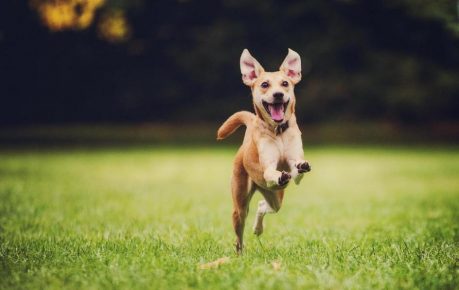
Sport is a great opportunity to keep your activity active. rocks in urban environments
A little is required from a person: a trained dog, sufficient amount of time and desire. Before doing any sports, be sure to consult your veterinarian: for each species have their contraindications.
Sports with a dog
Each sport with a dog has its own history and its own rules. Of course, there is no such diversity as in human sports, but what is created uses all the abilities of dogs of all breeds.
Agility
The most popular sport with a dog. Appeared in England in 1977. The program was developed by two comrades: P. Minwell and J. Varley. The idea was to diversify the familiar dog shows during a small show that they themselves will show tailed. In this case, the breed of the dog was not important.

Agility is the most popular sport among dogs and their owners
The competition made a splash at the first show (exhibition Crafts, 1978): Spectators were thrilled with excitement, agility and obedience. athletic dogs. Already in 1989, FCI recognized agility as a sport. international scale, in 1996 held the first world championship. FROM 2000, work is underway to include agility in the Olympic species sports.
The prototype for agility (from the English agility – agility) was equestrian sport, namely show jumping, where a horse with a rider should Pass the track with obstacles.

It looked like the first agility track
The basic rules of agility:
- The task of the dog is to pass the track in the minimum time without mistakes.
- The task of the conductor (or handler, as it is also called) is voice and gesture commands to guide the dog. Additional Motivators (toys, treats, touches) are prohibited.
- There is no collar or leash on the dog during the competition.
- The arrangement and order of obstacles varies on each competition. A few minutes before the start, handlers without dogs allowed to get acquainted with the track. During familiarization by the handler compiled tactics of passage.
Agility shells are divided into contact and non-contact.

Active dogs just love agility
The rules also depend on the agility class:
- standard – a numbered strip of 15 (for beginners) or 20 (for experienced) obstacles;
- jumping – obstacle course (numbered) for jumping, sometimes with additional tunnel obstacles or “snakes.”
- joker, jackpot – an unnumbered strip that runs in two stages: first (introductory) – obstacles selected by the conductor, the second (final) is the obstacle chosen by the judge;
- snooker – a track of three obstacles for jumping and six another type. The dog passes one obstacle first jumping, then one of the other six (all to choose from handler);
- relay race – teams are formed, selected according to the size of the dogs, who alternately perform the “Standard” track with the transmission relay races.
Dogs participating in agility must be at least one year old. Them divided into three classes:
- mini (S) – up to 35 cm at the withers;
- midi (M) – 35–43 cm;
- maxi (L) – more than 43 cm.
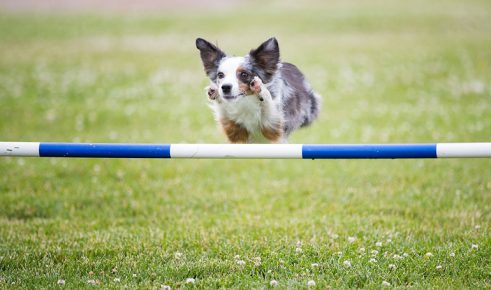
Agility dogs are divided by size
In class S, frequent winners are Spitz, class M is Sheltie, class L – Border Collie.
Each shell has its own teams that need a dog to train:
- “Home!”, “Hill!” – for a hill;
- “Kach!” – for a swing;
- “Boom!” – for a boom;
- “Tun!”, “Bottom!” – for the tunnel;
- “Up!”, “Jump!”, “Hop!”, “Bar!” – for all types of barriers;
- “Circle!”, “Tire!” – for the ring;
- “Trrrrr!” – for slalom (“snakes”);
- for the podium square on which the dog stops at a certain time – “Sit!”, “Stand!” or “Lie down!”.
Photo Gallery: Agility Shells

- Barrier heights vary with dog size

- Boom – contact shell
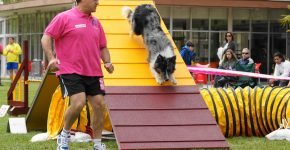
- Special elevations are mounted in the hill so that the dog has easy to climb
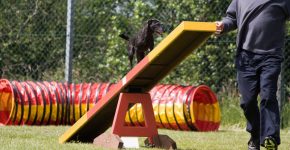
- Many dogs are frightened by the movement of the swing under their paws.
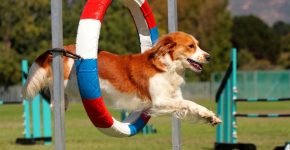
- The ring cannot be touched
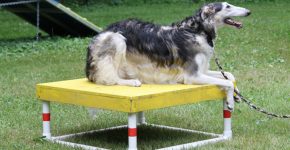
- Dogs show shutter speed on the podium.

- Slalom, or “snake”, you need to go as quickly as possible
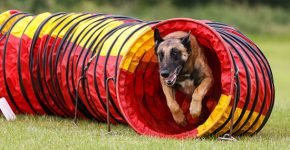
- The tunnel refers to contact obstacles
Agility is not recommended for elongated rocks: bassets, taxis, etc.
Whitpooling
The name comes from two English words: weight (“weight”) and pull, that is, pull. This is not the newest species. Sports: It arose even during the Gold Rush in Alaska. Then the dogs helped people transport goods in a sleigh, and often one dog had to carry not the easiest luggage.
In literature, something similar to wave pulling was first described by Jack. London (The Call of the Ancestors book). It has a backing dog (a cross between a shepherd and St. Bernard) weighing 69 kg moved and drove about 100 m frozen to ice sledges with a load of half a ton.

Any dog can do whitpooling
Waitingpool developed in parallel with sledding and was even part of it: dogs that are best at racing after competed in cargo pulling. Separate sport whitpooling became in 1978.
In wave pulling, dogs are categorized by weight, in each the system has its own division. Also for each dog in accordance with the category is assigned the starting weight, which may increase from round to round (which usually 5 to 12 in one competition).

Some dogs can weight more than 1,500 kg.
For whitpooling, the dog is sewn a special harness. She It should be ideal for the dog so as not to cause injury. At the main thing to learn is to interest the dog and teach her not to be afraid pull the load. Start with a small weight, gradually increasing it.
The breed of the dog is unimportant. But best with wave pulling gambling pit bulls, amstaffs, Argentinean dogs, as well as large and sledding breeds.

Wavepulling requires high-quality equipment, suitable your dog
Frisbee dog
The story of frisbee with a dog began in 1974 in Los Angeles, when during a baseball game, Whippet Ashley and her master A. Stein for 8 minutes they surprised the spectators at the stadium with incredible frisbee tricks. Stein was arrested since his performance was illegal, but he was saved by Irv Lander – one of the spectators, a businessman and animal lover. He helped Stein develop and popularize dog frisbee.
There are two types of dog frisbee:
- Mini distance. The dog needs to catch the drive at maximum distance from the person. Over the range accrue from 0 to 3 points. A dog is entitled to a bonus if it breaks away from the capture land with all paws.
- Frisbee freestyle. Spectacular sport with complete creative freedom. The dog and the owner perform various tricks to music the program compiled by them.
Video: Frisbee Freestyle
For dog frisbee you only need a set of special frisbee plates. The dog must be strong, agile, hardy and trained. For such contact sport, the dog and owner must Feel and understand each other perfectly. Best in dog frisbee shepherd dogs and small greyhounds show themselves – they very agile and jumping.
Dog training freestyle, or dancing with a dog
Sport was born in the late 1980s. At first it looked like a horse dressage and was called “Heelwork to Music” (movement nearby under music). The prototype for freestyle was the norm of obedience. A little bit later the movements varied with tricks: “snake”, jumping, walking on hind legs and others. The first official competition was held in 2005 year.
Video: Dog Training Freestyle
Freestyle is most appreciated in freestyle. (which is the owner of the dog, choosing music, costume and tricks), coherence during performance and dog obedience. Any dogs can participate in freestyle.
Riding (Sled Racing)
Sled dogs are considered one of the oldest among all. rocks. Many thousands of years ago, they helped indigenous peoples North carry goods on a sleigh. The first sled races conducted in Alaska between teams of gold diggers. Lasted such races are sometimes for several days, during one race the team could go over 100 km.
Riding is now more diverse: a dog can pull traditional sledges, as well as skis (skijoring) and small sledges (skipulling).
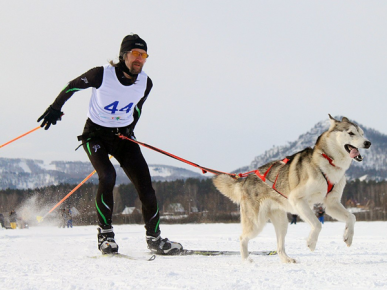
1-2 dogs can participate in skijoring
Sled racing is divided into several types:
- sprint;
- average distance 40–100km;
- long distance 100+ km;
- multi-day race.
There can be up to 12 dogs in one harness.
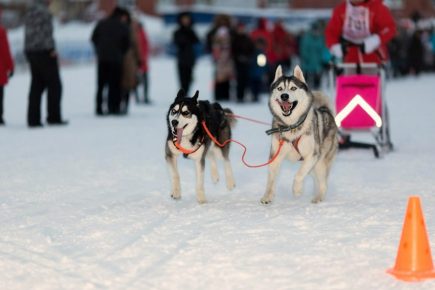
Dog Sports – Fun
1-2 dogs are usually used in skijoring and 1-4 dogs in skipping dogs. Teams from the owner and dogs are divided in size.
What equipment will be needed for riding:
- riding harness;
- pull – shock-absorbing cable attached to the harness (during operation several dogs) or to the skier’s belt (in discipline skijoring);
- belt for the skier – in the discipline skijoring is attached to it pull, belt softens and distributes the pressure of the pulling dog;
- harness – a design that combines strapped to harnesses pulls and sledging;
- sledges (or other types of sleds);
- boots – when racing long distances and in extreme low temperatures use safety shoes to prevent paw pad injuries;
- skis and poles.
Dogs must obey to succeed host commands. In every big team there is a leader, he sets referral to all dogs.
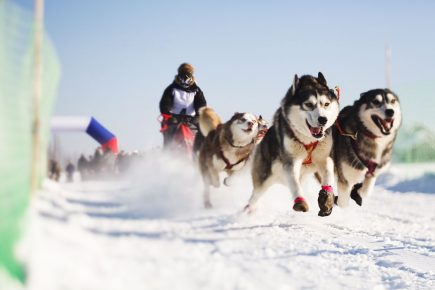
Dog sledding can go up to 45 km per day
Any dog of medium and medium size can participate in sledding. large breeds. Of course, riding rocks are best shown. and large hounds.
Dryland
One of the varieties of riding sports. Produced by snowless tracks. Dryland is an international sport. On him competitions are regularly held.
What commands are used for dryland:
- left turn;
- right turn;
- stop;
- progress;
- slowdown;
- acceleration;
- increase in jerk force;
- ignoring distraction.
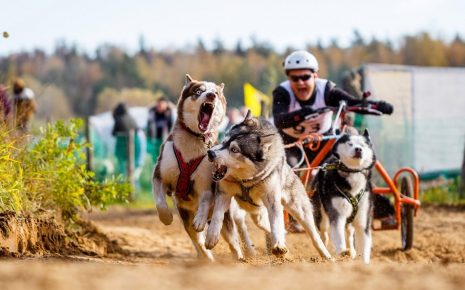
The driver uses special commands
Dryland is divided into 3 disciplines.
Canicross
Canicross is a dog runner competition. Dog as in Skijoring is connected with a person by a special harness.
For caniros need:
- special belt;
- riding harness;
- pull – a cord 2.5 meters long with shock absorbers connecting runner and dog.
For canyros use sledding, hunting, mestizo and outbred dogs. Both the owner and the dog must be in good physical fitness, which is achieved only by regular training. As a rule, 1-2 dogs interact with 1 person.

The fastest team wins in canyros
Bike joring
In bike joring, dogs pull a bike. In one harness usually not more than 4 dogs.
Equipment:
- Special design harness, individually tailored for every dog.
- Pull – the dog fastens to the bicycle with a special cable with shock absorber, allowing to dampen sharp jerks at starts and braking.
- Helmet for a cyclist.
- Safety glasses for cyclists, especially when riding in the forest terrain.
- Bicycle gloves for long workouts and rides long distances.
- Springer – a special device that prevents getting pull under the bike wheel. It is important that the harness does not fastened to the handles of the steering wheel.
In bike joring, there are pretty strict rules about age and dog health. Each caudate participant undergoes a veterinary check before starting.

Kurzhaar recognized as one of the best breeds for bike joring
The best breeds for bike joring are recognized kurtshaar, drathaar and sled dogs. But other breeds can participate in this form. sports.
Karting
In karting, dogs pull “sledges on wheels,” or cards. Total there are two types of karts – a single-seat gig and three-four-wheeled cards.
When riding a gig, the dog pulls the cart itself and the person in it. You can harness any number of dogs, the main thing is that the weight of the gig with a person did not exceed the total weight of the dogs more than three times.
Riding a map is the same as riding a sled. Harness up to 12 dogs are allowed, one of which is the leader and sets direction. Races are held the same way as in the snow, with the same equipment, rules and teams.
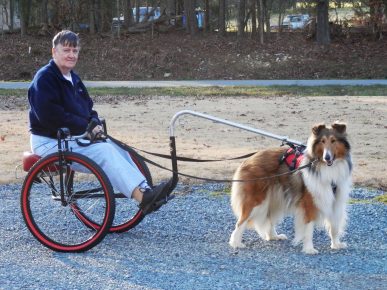
In dog karting, the main thing is that the load does not exceed the weight of the dog more, than three times
Riding, cops and shepherds are great for riding on the map. breed.
Dog pulling (tug of war)
Dog-pulling appeared recently in Russia. Initiators the first competitions were members of the Club of breed lovers American Pit Bull Terrier. The participants of the first competitions were only pit bulls, later owners were also interested in dog-pulling other breeds.
The competition involves dogs of three weight groups:
- up to 25 kg;
- 25–35 kg;
- 35–45 kg.

Dog pulling – Russian sport
The rules are as follows:
- A rope of 3 m length is selected.
- Its middle is indicated.
- A rope stretches through an opaque “wall”.
- On either side of the wall are rival dogs that begin to pull the rope on command.
The grading system is simple: for every 10 seconds you drag the dog 1 point is assigned. For the victory is given 10 points. Wins the dog with the most points in the competition.
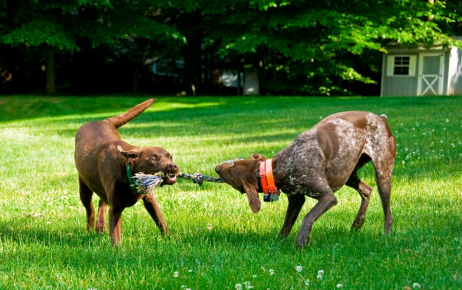
Dogs like to pull a rope
The breed can be any, the main thing is that the dog should be at least of the year.
Coursing
Coursing is running after the bait. Used to be trained in this way greyhound dogs, now coursing is available to everyone.
The following parameters are evaluated during the competition. dogs:
- intelligence;
- maneuverability;
- excitement;
- speed;
- endurance.
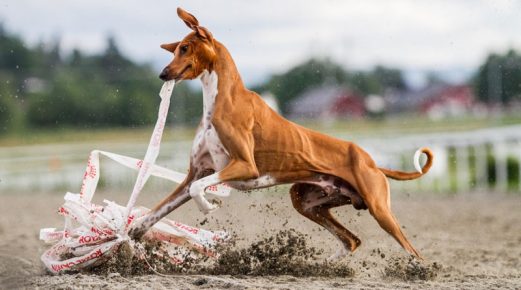
Dogs involved in the course are agile and hardy.
Coursing tracks can be from 400 to 700 m (for basenji, Whippets and Italian Greyhounds) and from 0.5 to 1 km (for other breeds). Bait moving with sharp bends at various angles, experiencing reaction speed and maneuverability. Best in this sport itself show greyhounds.
Dog racing
Dog racing is the same as horse racing. Dogs are running race for artificial bait. The dog who wins first came to the finish line.
Since the 18th century, in England, where races were born, they were considered entertainment for aristocrats. Dogs were betting, best dogs valuable prizes won. Previously, only Greyhounds, but now other greyhounds can compete in speed.
Competitions are held at hippodromes or movie theaters. Them used mainly as a way to maintain physical and working forms of greyhounds.
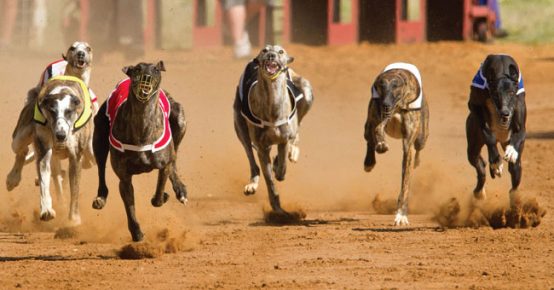
Greyhounds – a traditional breed for dog racing
In some countries, dog racing popularity ratings are higher. than football.
Rally obedience
Rally obedience is a young kind of cynological sport, which is a kind of obedience standard. Many exercises are based on the rules of the international class of obedience, recognized by the IFF, but modified. Rally obedience closer to gaming types of training than obedience.
It is more spectacular, less rigid in judging and requirements for dog and guide standard. Dog and guide walk a sequence of exercises with various complications in which the dog demonstrates skills of moving nearby, taking positions, aporting.
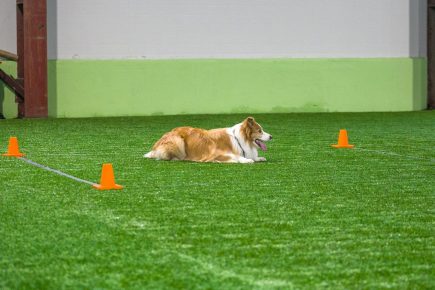
Rally obedience spectacular obedience
This sport is available for conductors of any level. training and dogs of any breed and age
Pitch and go
Pitch & Go appeared in Japan at the end of the 20th century. This kind of sports seems to be pure porting. Dog must team to bring the owner a thrown item and do it according to regulations.
Pitch and go can be held on land and in water. Dogs divided into categories by height:
- up to 35 cm;
- 35–43 cm;
- more than 43 cm.
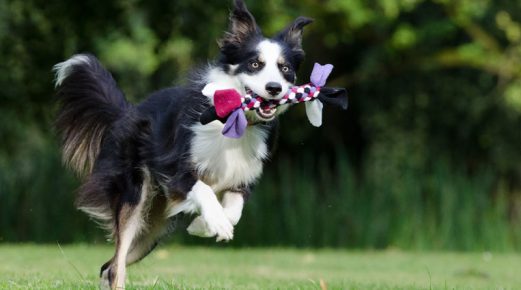
Pitch & Go Dogs Must Have Aportation Skills
The dog is allowed to throw any objects except frisbee. The performance of one pair lasts 90 seconds. Competitions allowed any dogs, except aggressive and shy.
Fast track
Fasttrack is a combination of agility and OKD. During the competition dogs pass an obstacle course as in agility, but with a delay in end of track. During the passage, the ability to change direction of movement on the team, the dog’s knowledge of basic commands and its reaction to a shot and a muzzle.
Fasttrack is a very young sport that is only gaining popularity. Any dogs can participate, division into categories are the same as in agility.

Fasttrack is like agility
Flyball
Flyball is a story about how the owner is tired of throwing toys to his dog and he made out of a tennis throwing machine balls for the flyball, which served the dog balls, if that I pressed the button. It happened in the late 1960s. Later B. Witeruoks, daughter of the famous trainer, became interested installation. To it were added several barriers that dogs pass. on the way to installation. In 1983, the first competition.
In flyball, teams of 4 dogs are formed. Two or more teams can run parallel tracks at the same time. The task of the dog is pass the barriers, start the flyball installation, grab the ball and come back again breaking the barriers. The fastest wins team.
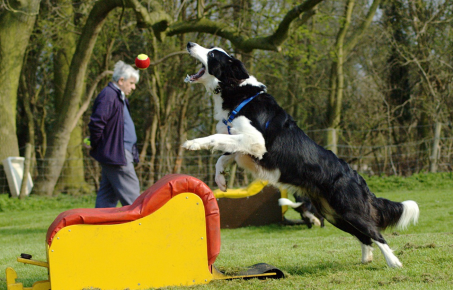
In flyball you need to catch the ball
Dock diving
Dock diving is a young, unrecognized sport in which dogs compete in the length or height of the jump. Competitions are held in the following way:
- A toy is suspended above the marked pool (or throws it into the water host).
- Dog on command jumps after her.
- The dog that jumps farthest or higher is the winner.
The most popular sport in the homeland is in North America. Held in the summer, available to dogs of all breeds. Dogs share into categories by size.
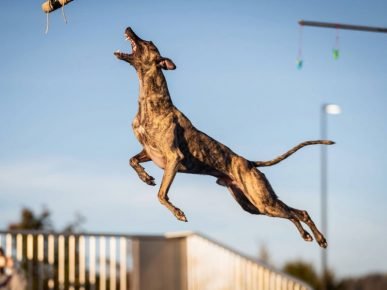
In diving, dogs compete in the length and height of the jump.
Knowwork
Noswork is a sport resembling a search dog service. The task of the nosworker dog is to find the source of the smell as soon as possible. in the selected area. Beginners compete in finding goodies or toys in several containers. More experienced dogs may find unfamiliar item on any terrain.
The dogs with the sharpest sense of smell are the most successful in hatching: hounds, Shepherd dogs and purebred dogs. Any dogs with any can participate health, which is a significant advantage of sports.
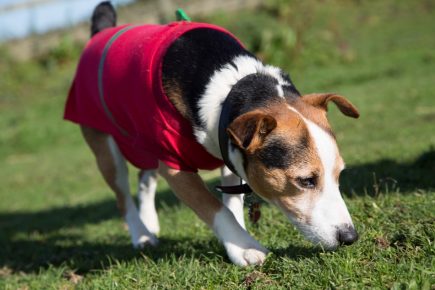
Noswork develops dog search abilities
Whatever sport you choose, it will definitely help you not only train the dog, but learn to understand it. Dog in in turn, it will become not only stronger, but also more devoted, and more obediently. Sport unites not only people with people, but also people with dogs.







